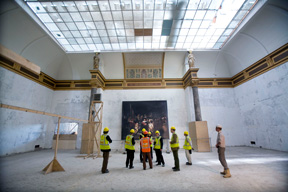The New Rijksmuseum
Het Nieuwe Rijksmuseum THE NETHERLANDS / 2008 / Dutch, English, Spanish / Color / Video / 120 min
THE NETHERLANDS / 2008 / Dutch, English, Spanish / Color / Video / 120 min
Director: Oeke Hoogendijk
Photography: Sander Snoep, Gregor Meerman, Adri Schrover, Paul Cohen
Editing: Gys Zevenbergen
Sound: Mark Wessner
Music: Eelco van de Meeberg, Christiaan van Hemert
World Sales: NPO Sales
Producer, Source: Pieter van Huystee www.pvhfilm.nl/hetnieuwerijksmuseum
The Dutch National Museum in Amsterdam, known for Rembrandt’s The Night Watch. As soon as plans for a large-scale renovation are announced, a controversy erupts among the city’s inhabitants. Proposed changes include the construction of a restaurant and museum shop, reducing the space that the public has free access to. Unaware of the fuss above ground, numerous masterpieces slumber in the cellar vaults. Developing into a human drama, with the museum director’s job on the line, the film brings us into close contact with the museum’s inner workings.
[Director’s Statement] For the last four years I’ve filmed the fascinating process of the renovation and expansion of the Rijksmuseum in Amsterdam. Spanish architects Cruz and Ortiz designed magnificent new wings and corridors. Demolition work started, with “the most beautiful art museum imaginable” to reopen in 2008. The release of the film was scheduled to coincide with the completion of the renovation. Instead the film was released in 2008 and the museum will remain closed, until at least 2013.
Demolition turns out to be easier than building. The historic operation is hampered by militant cyclists, the city district, and baffling regulations. While the museum staff is waiting for new building permits, work in the old building is on hold for more than a year. The building is empty, there is a lack of activity in it. The camera tries to visualize and capture the painful silence in the building. Meanwhile the film shows how, in the offices of the museum staff, frustrations mount and motivation wanes.
Instead of a film on the successful creation of a new museum, my film turned out to be a film about the loss of control and the many mishaps during the first years of the creation of the new Rijksmuseum. It reveals how the master plan of two architects could be diluted and turned into a pale compromise.
My goal with this film was to make the audience feel a part of the ongoing struggle to create the new museum. Ironically, the project also reflects how decision-making in our democracy can work sometimes. As one of the architects remarks in the film: “This is not democracy, this is a perversion of democracy.”
 Oeke Hoogendijk
Oeke Hoogendijk
Born in 1961 in the Netherlands, Hoogendijk started her career as a theater director. Since 1997 she has been directing documentaries for television, including Een gelukkige tijd (The Saved, 1998), about 700 Dutch Jews who escaped the Holocaust; the film won the Best Television Documentary at the Dutch Academy Awards. The Holocaust Experience (2002) examined how the memory of the Holocaust is kept alive in Europe and the United States. She is now working on The New Rijksmuseum, Part Two. |
